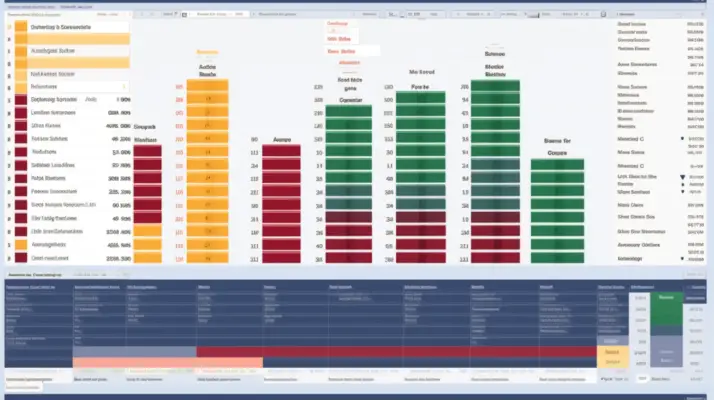ISO 27001:2022 is an international standard for information security management systems (ISMS) that systematically protects sensitive information within organizations. Risk assessment is a critical component of implementing the ISO 27001 standard, as it helps organizations identify, analyze, and treat information security risks.
In this article, we will provide an overview of the ISO 27001 risk assessment methodology and focus on how businesses in the U.S., U.K., Australia, and New Zealand can use this methodology to ensure the confidentiality, integrity, and availability of their information.
We will begin by looking at the various steps in the risk assessment process, including risk identification, analysis, and developing a risk treatment plan.
We will also explore the importance of ongoing monitoring, review, and improvement to ensure the effectiveness of the risk assessment methodology.

Background
The ISO 27001 risk assessment methodology is a systematic and structured approach to identify, analyze, and evaluate risks to information security within an organization. It aims to identify potential threats, vulnerabilities, and impacts and determine the risks’ likelihood and potential consequences.
Intellectual property, mobile devices, and the need for acceptable risk underscore the relevance of robust security risk assessments in our current digital landscape. Asset owners must ensure the acceptability of risk controls through a consistent risk assessment process.
Key risk management tools include frameworks such as the ISO risk assessment methodology, outlined in Annex A, and the built-in risk matrix found in common risk management frameworks.
The effective risk management steps embedded in an ISMS risk assessment report helped shape the entire risk management structure. A dynamic risk assessment, informed by relevant and high-priority risks, helps maintain a sound risk posture.
Risk ownership, risk scale, and risk situations should all be factored into the current risk management program, whether analyzed through a scenario- or asset-based risk assessment.
A formal risk assessment methodology, an integrated risk assessment approach, and a consistent risk assessment yearly are crucial to understanding the levels of risk.
Scenario-based risk assessment considers the threat environment, the identified threats in a threat database, and the threat level, considering the potential for damage, whether it’s financial or security incident damage.
In compliance, platforms like a compliance automation platform simplify the process. Compliance experts, leveraging tools such as Compliance Hubs, monitor compliance posture and obligations and produce compliance reports.
Compliance Statistics, presented in accessible audit environments, provide measurable metrics to gauge the effectiveness of a healthcare compliance program or PCI compliance measures.
Compliance with industry standards, compliance terms, and particularly with ISO standards, are all part of the larger compliance project. The role third-party compliance auditor or an audit partner is critical in this respect, conducting surveillance audits, planning for audits, and executing the audit exercise based on a comprehensive list of controls and requirements.
Remembering risk assessments fit within the broader risk management methodology is important. A minimal list of partners today, a company’s level, its business impact, and an impact score should all be considered when dealing with risk with security controls.
The potential damage a security incident can cause a company and its financial impact are all essential considerations in a comprehensive risk and compliance program.
The main objectives of the risk assessment process are to enable informed decision-making, prioritize risk treatment actions, and ensure the effective implementation of controls to mitigate identified risks.
Overview of ISO 27001 Risk Assessment Methodology
The ISO 27001 risk assessment methodology overview provides a comprehensive and systematic approach to identifying and evaluating potential security risks, instilling a sense of urgency and concern in the audience.
This methodology, outlined in the ISO 27001 standard, consists of various steps guiding organizations through risk assessment.
Firstly, the risk identification stage involves identifying and documenting all potential risks to the organization’s information assets.
Next, the risk assessment process evaluates these risks’ likelihood and potential impact. The risk level is determined by considering the likelihood and impact together.
The risk assessment report documents the findings and serves as a basis for decision-making.
Finally, the risk treatment plan outlines measures to mitigate or manage identified risks.
This methodology ensures a structured and thorough approach to risk management within organizations.
Objectives of Risk Assessment
One of the key aims of conducting a risk assessment is to systematically identify and evaluate potential vulnerabilities and threats to an organization’s information assets. By doing so, organizations can understand the risks they face and make informed decisions on how to mitigate them.
Risk assessment objectives include determining the likelihood of risks occurring, assessing the potential impact of those risks, and identifying appropriate security controls to mitigate them. Additionally, risk assessments help establish risk acceptance criteria and assign risk owners within the organization.
To engage the audience, a table can be included to illustrate the different types of risks, their likelihood, and the resulting residual risk. For example:
| Type of Risk | Likelihood | Residual Risk |
|---|---|---|
| Cyberattacks | High | Medium |
| Data breaches | Medium | Low |
| Physical theft | Low | Negligible |
Risk Identification
The first key point is identifying potential risks, which involves identifying all possible threats and vulnerabilities to the organization’s information assets.
The second point is analyzing potential risks, which involves assessing the likelihood and impact of each identified risk.
Finally, documenting identified risks is crucial for maintaining a record of them and their associated information for future reference and decision-making.
Identifying Potential Risks
Identifying potential risks in the ISO 27001 risk assessment methodology involves a comprehensive analysis of the organizational environment to ensure the thorough identification of vulnerabilities and threats.
The risk assessment procedure aims to assess the potential impact of security incidents and the associated damage on the organization’s assets.
This assessment is conducted through a systematic and asset-based approach, which involves evaluating the likelihood of various security risks and their potential impact on the organization.
Organizations often utilize a risk assessment template to aid in this process that provides a structured framework for identifying and documenting potential risks.
Incorporating compliance and audit requirements into the risk assessment methodology, organizations can proactively identify potential risks and implement appropriate controls to mitigate their impact on their overall security posture.
Analyzing Potential Risks
To comprehensively analyse potential risks, an organization must carefully evaluate the likelihood and potential impact of security incidents on its assets through a systematic and asset-based approach. This involves using risk assessment matrices to assess the probability and severity of each identified risk.
The organization should also consider the risk treatment options available and prioritize them based on their potential impact and the organization’s risk appetite. Internal audits can be conducted to verify the effectiveness of the risk management approach and identify any gaps or areas for improvement.
Implementing a risk management plan involves documenting the identified risks, maintaining an asset register, and developing a treatment plan for each risk. This ensures that the organization’s security management is proactive and effective in mitigating potential risks.
Documenting Identified Risks
A crucial step in the risk management process involves documenting the identified risks using a comprehensive and structured approach. This documentation is vital to the overall risk assessment methodology, specifically within the ISO 27001 framework.
Thoroughly documenting the identified risks, organizations can effectively communicate and analyze the potential threats and vulnerabilities they face. The risk report is a reference point for the risk treatment process, enabling organizations to prioritize and allocate resources accordingly.
Additionally, documenting risk scenarios helps organizations understand the potential consequences of each risk and develop appropriate risk controls.
Moreover, the risk assessment requirements outlined in ISO 27001 emphasize the importance of documenting the risk identification process, ensuring transparency and accountability in the risk management process.
Risk Analysis
This paragraph introduces a discussion on the subtopic of Risk Analysis, focusing on three key points:
- Understanding the Risk Profile: Organizations aim to involve analyzing various factors, such as the risks’ nature, likelihood of occurrence, and potential consequences they may have on the organization.
- Assessing Likelihood and Impact of Risks: Risk analysis is essential to evaluate risks’ probability and potential consequences. This helps organizations prioritize and allocate resources to address the most significant risks that could substantially impact their operations.
- Establishing Risk Response Strategies: Once risks have been identified and their likelihood and impact assessed, organizations must develop plans and actions to mitigate or respond to them. This involves establishing risk response strategies that can help minimize the impact of identified risks on the organization’s objectives and overall performance.
Adherence to these three key points, organizations can effectively analyze and manage risks, making informed decisions to protect their interests and ensure the successful achievement of their goals.
Understanding the Risk Profile
Understanding the Risk Profile involves a comprehensive analysis of the potential threats, vulnerabilities, and impacts that an organization may face, providing valuable insights into the overall security posture and enabling informed decision-making to mitigate risks effectively.
To emphasize the importance of understanding the risk profile, consider the following points:
- The risk assessment methodology should align with the ISO 27001 standard, ensuring a systematic and consistent approach.
- It is crucial to determine the organization’s risk appetite, which defines the level of risk that the organization is willing to accept.
- The risk summary report should be prepared, presenting the identified risks, their likelihood, and potential impacts.
- Clearly defined roles and responsibilities of the parties responsible for risk management are essential for effective implementation.
Organizations can measure and prioritize risks based on their potential impact and likelihood by adopting a quantitative approach. This enables them to allocate resources efficiently and effectively.
The risk summary report also serves as a communication tool, providing valuable information for the certification auditor and facilitating continuous improvement efforts.
Assessing Likelihood and Impact of Risks
To evaluate the likelihood and impact of risks, organizations can utilize a quantitative approach to prioritize and allocate resources efficiently based on the potential consequences and probability of occurrence.
Organizations can identify potential and security vulnerabilities within their systems and processes by assessing the likelihood of occurrence. This information can then be used to develop an action plan or plan of action to mitigate these risks effectively.
Moreover, goals for implementation can be set to ensure that the necessary measures are taken to minimize the impact of identified risks. This implementation project step requires the involvement of company management and the integration of risk assessment activities into the overall business strategy.
Adoption this approach, organizations can align their risk management efforts with best practices followed by cutting-edge companies in the industry.
Establishing Risk Response Strategies
This crucial phase identifies and prioritizes appropriate actions to address identified risks. By developing risk response strategies, organizations can effectively manage and mitigate potential threats to their information security.
To achieve this, the risk assessment methodology provides a framework for creating risk mitigation plans based on predefined risk criteria. These plans involve implementing specific risk controls to minimize the impact of risk scenarios and situations.
In this way, organizations can proactively address potential risks and ensure the security of their sensitive information.
The key points of this section are as follows:
- Risk assessment methodology provides a framework for Establishing Risk Response Strategies.
- Risk response strategies prioritize appropriate actions to address identified risks.
- Risk mitigation plans are developed based on predefined risk criteria.
- Risk controls are implemented to minimize the impact of risk scenarios and situations.
- The aim is to proactively address potential risks and ensure the security of sensitive information.
Risk Treatment Plan
Developing a comprehensive risk treatment plan involves:
- Identifying and assessing the risks identified in the risk analysis.
- Determining the appropriate treatment options for each risk.
- Prioritizing the treatment actions.
Implementing the risk treatment plan involves:
- Executing the identified treatment actions.
- Monitoring their effectiveness.
- Making any necessary adjustments as the plan is executed.
Developing a Comprehensive Risk Treatment Plan
Developing a comprehensive risk treatment plan necessitates a systematic and thorough analysis of identified risks to determine appropriate measures for mitigating or managing those risks.
This process involves utilizing a standardized risk assessment methodology, such as an integrated or scenario-based approach. By conducting a robust risk assessment process, organizations can identify and prioritize risks based on their potential impact and likelihood of occurrence.
Risk treatment activities can then be tailored to address these specific risks through risk avoidance, reduction, transfer, or acceptance strategies.
Developing a verifiable risk assessment document that outlines the identified risks, treatment measures, and their effectiveness is crucial.
This document is a crucial component of a strong ISO risk assessment and compliance program, demonstrating a proactive and systematic approach to risk management.
Implementing the Risk Treatment Plan
Implementing the risk treatment plan requires a coordinated and systematic approach, ensuring that the identified measures for mitigating or managing risks are effectively implemented, like a well-orchestrated symphony guided by a conductor.
To successfully implement the risk treatment plan in line with the ISO 27001 risk assessment methodology, organizations should consider the following key steps:
- Assigning responsibilities: Clearly define roles and responsibilities for individuals involved in the implementation process.
- Developing action plans: Create detailed plans that outline the specific actions needed to address each identified risk.
- Allocating resources: Ensure that the necessary resources, such as budget, personnel, and technology, are allocated to support the implementation efforts.
- Establishing timelines: Set realistic timelines for implementing each action plan and monitor progress regularly.
- Monitoring and reviewing: Continuously monitor the implemented measures’ effectiveness and adequacy.
Following these steps, organizations can effectively implement risk treatment plan and enhance their overall information security posture.

Monitoring, Review, and Improvement
To enhance the effectiveness of the ISO 27001 risk assessment methodology, a comprehensive approach to monitoring, reviewing, and improving the process is essential.
Monitoring the risk assessment methodology allows organizations to track the progress of their risk management efforts and identify any areas that may require further attention.
Regular review of the risk assessments ensures that they remain up-to-date and accurate, considering any changes in the organization’s environment.
Improvement of the risk assessment methodology involves identifying and implementing enhancements to make the process more efficient and effective. This could include refining the risk assessment frequency to ensure that it aligns with the organization’s risk appetite and prioritizing high-risk scenarios.
Additionally, organizations should continuously evaluate and update their risk scenarios to reflect the evolving threat landscape and assess the effectiveness of security controls in mitigating risk.
ISO 27001 Risk Assessment PDF
The ISO 27001 Risk Assessment is integral to any effective information security management system (ISMS). This systematic process helps organizations identify, evaluate, and address the security risks associated with their information assets.
Implementing an ISO 27001 Risk Assessment offers numerous benefits, including enhanced data protection, compliance with regulatory requirements, and establishing a robust security culture. It involves key steps like asset identification, threat and risk estimation, risk treatment, and regular risk assessment review and update.
Tools like a compliance automation platform can simplify the process, ensuring organizations meet ISO standards and maintain a strong compliance posture. Regular audits, including third-party certification audits, reinforce the effectiveness of these measures.
Despite the complexities involved, the ISO 27001 Risk Assessment is invaluable for safeguarding your organization’s most precious resources – its information assets. With the rising tide of cybersecurity threats, there’s never been a more critical time to ensure your risk management practices are up to the task.
Frequently Asked Questions
What are the key principles of ISO 27001 risk assessment methodology?
The key principles of ISO 27001 risk assessment methodology include systematic identification of assets, assessment of threats and vulnerabilities, determination of risk levels, implementation of controls, and continuous monitoring and improvement of the risk management process.
How does ISO 27001 risk assessment methodology differ from other risk assessment methodologies?
ISO 27001 risk assessment methodology differs from other risk assessment methodologies in its comprehensive approach, which includes identifying assets and threats, assessing vulnerabilities and impacts, and determining risk levels. It also emphasizes continual improvement and the integration of information security management processes.
What are the common challenges organizations face during the risk identification process?
Common challenges include inadequate expertise or understanding of risks, lack of comprehensive data or information, difficulty prioritizing risks, and organizational resistance to change or implementation of risk management practices.
Can ISO 27001 risk assessment methodology be applied to industries other than information security?
ISO 27001 risk assessment methodology can be applied to many industries beyond information security. Its systematic approach allows organizations to identify, analyze, and evaluate risks, making it adaptable for assessing risks in various sectors.
Are there any specific regulatory requirements that organizations need to consider when using ISO 27001 risk assessment methodology?
Specific regulatory requirements on the use of ISO 27001 risk assessment methodology. These requirements vary across industries and may include data protection laws, industry-specific regulations, and privacy laws.

Conclusion
The ISO 27001 risk assessment methodology is crucial for organizations to identify, analyze, and mitigate potential risks. By following a systematic approach, risks can be effectively managed to ensure the security of information assets.
This methodology includes risk identification, analysis, and the creation of a risk treatment plan. Continuous monitoring, review, and improvement are also essential for maintaining the effectiveness of the risk management process.
Implementing ISO 27001 can help organizations establish a robust framework for information security.

Chris Ekai is a Risk Management expert with over 10 years of experience in the field. He has a Master’s(MSc) degree in Risk Management from University of Portsmouth and is a CPA and Finance professional. He currently works as a Content Manager at Risk Publishing, writing about Enterprise Risk Management, Business Continuity Management and Project Management.

